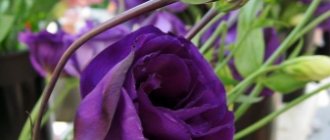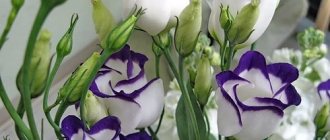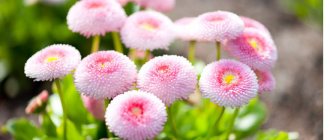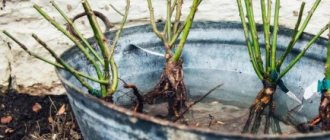- Description of eustoma
- Types and varieties of eustoma
- Russell's potted eustoma (Eustoma Russelianus)
- Garden eustoma grandiflorum (Eustoma Grandiflorum)
- Planting eustoma for seedlings
- Soil for growing eustoma
- Caring for eustoma seedlings and seedlings
- How to grow eustoma in peat tablets
- Prevention of diseases of eustoma seedlings
- Growing potted eustoma: care at home
- Watering and feeding eustoma
- Lighting and temperature conditions
- Eustoma flowering
- Eustoma after flowering: dormant period
Eustoma or Irish rose is a beautiful legendary flower native to North America. Despite its overseas roots, this culture has successfully taken root in our country.
Lisianthus is also grown by enterprising people, because a cut flower can stand in a vase for 18-20 days.
First of all, this plant is grown for cutting. Beautiful flowers, reminiscent of delicate silk half-opened roses, last a long time in bouquets. A wide palette of colors, the tenderness of the flower with amazing durability always surprises. Eustoma is grown as a garden, greenhouse, and indoor crop. And in any capacity, the plant will require very careful care, but even a novice gardener, having received the necessary knowledge about planting and care, will be able to enjoy a flowering plant in the garden or at home.
Description of eustoma
Known among flower growers also under the name of Russell's lisianthus, Irish, Japanese rose, Texas bell or love rose, eustoma is one of the most beautifully flowering crops. In both horticulture and floriculture, it is represented by only one species - grandiflora eustoma (eustoma grandiflorum).
Previously, three separate species were recognized in the genus Eustoma. However, joint work by employees of the Royal Botanic Gardens at Kew (UK) and the Missouri Botanical Garden (USA) to streamline the nomenclature of modern plant taxa, united the following species under a single name - Eustoma grandiflorum: Eustoma grandiflorum, Lisianthus - Eustoma Roussel's, or Russell's (Eustoma russellianum), Eustoma minor, Gentian minor, Western gentian, Blue marsh Eustoma (Eustoma exaltatum).
Wild form of eustoma.
Eustoma grandiflora is a luxurious plant from 30 to 90 cm in height with branched shoots, simple, elegant leaves with a bluish tint and flowers reminiscent of a hybrid of roses and poppies. Up to two dozen large luxurious flowers bloom on one plant per season, and due to the fact that they open not simultaneously, but alternately, eustoma remains attractive for an amazingly long time.
The ability of buds to bloom after the flowers wither is also preserved in bouquets: when buying eustoma or displaying it in vases, you can be sure that each bud will in turn turn into a beautiful Japanese rose. Each plant looks like a bouquet: due to its specific branching, strong, but slender, fan-shaped, eustoma really seems like a bouquet planted in a pot.
Eustoma, cultivar 'Borealis Blue' and yarrow cultivar 'Moonshine'.
Flowering of eustoma depends on the timing of sowing and begins 20 weeks after sowing. For classic garden eustomas, it starts in June-August and lasts until mid-autumn, because the plant will not stop delighting with flowers until the frost reaches -10 degrees and snow falls.
The color palette of eustoma today includes not only white, purple, pink, yellow, orange colors, but also various two-color and watercolor combinations. Compact indoor eustomas have colors that are usually clean and quite bright, while garden ones have a much wider range of colors. It even includes light green and fruity shades.
Variety of colors of eustoma.
The huge assortment of eustoma and its popularity all over the world are the merit of breeders in the USA and Japan. In the West, this plant is one of the most popular cut species, but here, too, this Japanese beauty is slowly gaining ground.
Types and varieties
Eustoma - growing from seeds at home
Most varieties of French rose have bright flowers and bloom long and profusely. Propagated by cuttings and seeds. Popular varieties have bell-shaped flowers, sometimes double. The advantages of hybrid varieties are early and long flowering, resistance to diseases and unfavorable conditions (temperature fluctuations, non-compliance with watering or feeding rules).
Eustoma white
Refers to hybrid varieties. The plant grows quickly and blooms early. Peak flowering of eustoma alba occurs in July. It is distinguished by large, large inflorescences with a pleasant aroma. The flower resembles a large beautiful rose. To grow eustoma at home, the pot should have a diameter of 10 to 20 cm.
White eustoma
Eustoma stunted
Varieties of low-growing eustoma are ideal for growing indoors. The plants are compact and grow no more than 20 cm in height. The diameter of the flowers is on average 5 cm. Against the background of a compact bush in a pot, the flowers contrast very nicely.
The color range of low-growing perennials is represented by blue, lilac, violet, pink, and white colors. The flowers are simple and funnel-shaped.
Low-growing varieties are very easy to grow using seeds. Seeds are placed in disposable peat pots. As soon as three pairs of leaves are formed, they can be planted in a larger pot. The root system of a potted plant is not injured during such planting.
Low growing lisianthus
Terry varieties
Terry varieties are suitable not only for growing in the garden, but also indoors. Many varieties of eustoma terry have been developed with all sorts of shades. You can find packages containing plant seeds with both dazzling white and almost dark purple hues. Here you can also find flowers of pink or red eustoma.
All varieties of terry eustomas are distinguished by their purity and richness of color. They bloom intensely for a long time.
Eustoma violet
The varieties are distinguished by petals of lilac, bluish, blue, and violet colors. Characterized by tall stature. Some large-flowered specimens can grow up to 80 cm in height.
Bushes of eustoma flowers of the Little Mermaid or Sapphire are characterized by intense and rapid growth. The flowers are large, up to 7 cm in diameter, double. Their core is dark purple, rich in color. The stamens are yellow.
Some purple varieties are specifically designed to be grown in pots indoors. Such bushes are compact: the height of some of them is from 13 to a maximum of 17 cm. The flowers are small, all of a rich purple hue.
Purple eustoma
Eustoma lavender
Another name for the varieties is light purple. In many ways, lavender French rose is similar to purple. The difference is in the double large light purple flower, reminiscent of a full rose. The plant is tall.
Lavender eustoma
Eustoma lilac
This perennial eustoma is very similar to violet eustoma. The difference is in the shade of the flowers: in an adult perennial they are a very beautiful dark purple or lilac shade.
Russell's potted eustoma (Eustoma Russelianus)
This flower has a small compact bush, its height rarely exceeds 30 centimeters. Let's get acquainted with the most popular varieties of potted eustoma:
Mermaid variety.
Lisianthus Little Bell.
The Mermaid variety has simple inflorescences up to 6 centimeters in diameter. The petals are pink-lilac or blue, the maximum height of the crop is 15 centimeters. The bush develops well and does not need pinching to form additional side shoots.
Lisianthus Light Bell is up to 15 centimeters tall with small simple inflorescences of different colors. The culture bushes well and does not require pinching of shoots.
Variety Fidelity.
Florida Pink variety.
Variety Fidelity is a beautiful flower with many white inflorescences. A feature of the culture is the spiral arrangement of peduncles.
The Florida Pink variety is a fairly compact bush up to 20 centimeters in height. The inflorescences are pink with simple petals that form a beautiful bouquet.
Rozzi variety.
Variety Sapphire.
The Rozzi variety is one of the tallest crops of the species in question, its height reaches 30 centimeters. Double inflorescences with white, blue or pink petals.
Variety Sapphire with simple or double petals. The inflorescences have different colors, the height of the bush reaches 30 centimeters.
Variety Echo.
Variety Aurora.
Garden eustoma grandiflorum (Eustoma Grandiflorum)
As the name suggests, this crop is grown as a garden plant. The flower is quite tall, similar in appearance to a rose, and is used for cutting and making bouquets.
Let us describe the popular varieties of large-flowered garden eustoma:
The Aurora variety of double lisianthus reaches 1.2 meters in height. Inflorescences of white, blue and pink shades. The peculiarity of the flower in question is the early formation of buds; it blooms two weeks earlier than the others.
Variety Echo with spreading thick stems up to 70 centimeters in height. It blooms early, forms large inflorescences, the petals have 11 different shades.
Heidi variety.
Variety Eustoma Flamenco.
Variety Heidi . A medium-height species with simple, numerous inflorescences, it comes in 15 different color combinations. The height of the bush does not exceed 90 centimeters.
Variety Eustoma Flamenco up to 1.2 meters in height. The culture has powerful, well-developed stems and simple but large inflorescences, their diameter reaches 8 centimeters. The main advantage of Flamenco is its low maintenance requirements.
Variety Variety Twinkie.
Variety Double White.
Variety Twinkie variety with simple inflorescences. Bushes up to 50 centimeters in height with pink, purple and yellow petals.
Variety Double White . A terry type with white inflorescences, a bush up to 70 centimeters in height, with powerful, erect shoots. It is low maintenance.
History and description of the plant
The popularity of eustoma is returning again. As is usually the case, a new round of popularity is due to the fact that new varieties of eustoma have appeared (see varieties with photos and names). This flower came to us from America, where it is called “Texas bell.”
Indeed, among the varieties and varieties of this plant, blue color predominates. And only breeders, after trying, were able to achieve the appearance of red and yellow (with shades) eustomas.
Tall varieties with large buds for cutting have also been developed. And low ones - for container plantings.
They are used in bouquets and look especially beautiful with roses and lilies. However, in the flowerbed these neighbors also complement each other. Eustoma buds in a half-opened state look like roses; bouquets of them alone look extremely picturesque. Light shades of flowers seem simply fabulous due to the translucency of the petals.
Planting eustoma for seedlings
The seeds of the crop in question are quite small; they are supplied to stores in the form of pills. You can collect your own seeds if you have these flowers on your site, but in this case the difference between the parent and subsequent forms will be more and more felt every year.
Collecting seeds for seedlings:
- In order for the seeds to ripen, it is necessary to remove some of the inflorescences and move the plant indoors at the end of autumn.
- When frost occurs, the plant pots should be taken to a warm place and trimmed, leaving two pairs of leaves.
- Provide a temperature of 8 - 10 degrees, reduce watering, stop fertilizing. The flower remains in this state until March.
- The plant is well pollinated by insects and produces seeds in special boxes. Collecting such seeds is not difficult.
- First and second generation hybrids tend to inherit the traits of the parent plants, so feel free to collect seeds from your lisianthus plants within two years.
- Third-generation hybrids will not inherit the characteristics of the original plants, but as an experiment, you can try to sow seeds collected from third-generation plants.
Irish rose seeds.
Note! Coated seeds do not require preliminary preparation, because their shell already contains a sufficient amount of microelements and other nutrients.
Lisianthus flowers - an organic decoration for home and celebrations (with photo)
Eustoma, which belongs to the Gentian family, is native to Central America with its humid, warm climate. If previously lisianthus flower seeds were available only to professional flower growers, now any variety of lisianthus can be purchased in every flower shop or on a specialized website. In fact, lisianthus flowers are an organic decoration for any celebration and home interior. Look at the photo of lisianthus flowers in various applications: If you want to purchase a specific variety of flowers, you can consult with specialists or view photos of lisianthus on the Internet with the names signed under them. It is also worth considering that for a home business, growing different varieties of these bright, non-standard representatives of the flora can be a real financial boon. Low-growing varieties are used as potted decorations, while tall varieties are used for making bouquets.
Compositions of such bright, original flowers are often used by florists as interior decoration and decorative elements at various celebrations. Lisianthus can also play an important role in a wedding bouquet.
Soil for growing eustoma
We prepare the soil for sowing seedlings from equal parts of peat, garden soil and sifted sand. The end result should be soil with a neutral acid reaction. You can use Saintpaulia soil from store-bought mixtures.
Before moving to seedling containers, the soil is disinfected in a solution of potassium permanganate or placed in the oven for 30-40 minutes. There the earth is calcined at maximum temperature. The container for sowing can be special plastic boxes, disposable plastic cups or peat humus pots. Drainage from small pebbles is placed in the boxes and only after that the nutrient substrate is filled in.
Seed germination should occur in the light, so the grains are placed on slightly compacted and moistened soil, but not sprinkled with soil. To destroy the protective shell, the seeds are lightly sprayed with a spray bottle, then the containers are covered with a plastic bag or glass.
On a note! For better germination, seedlings are placed on a well-lit windowsill in a room with a temperature range of +20...+25 degrees.
Before emergence, the soil should be moistened with a spray bottle as needed. With the right approach, the first shoots will appear within two weeks from the date of sowing the seeds. Next, remove the cover and begin to care for the young plants.
Agricultural technology for seed germination
Seeds are sown starting in January. The seeds themselves are small and sold in the form of granules. They germinate rather poorly; 55-60% germination is considered a good result. The soil for germination should be light, not acidic. You can buy it ready-made, or prepare it yourself: mix garden soil, coarse sand and peat. The soil should be moist, the seeds should be spread over the surface, slightly pressed, and sprinkled with water on top.
Cover with glass or polyethylene, place in a warm and well-lit place, not forgetting to ventilate daily.
It is advisable to lower the temperature to 10 degrees at night, and add additional lighting during the day. The first shoots appear after one and a half to two weeks. From this moment on, water the seedlings less often and transfer them to a cool place.
When two leaves appear, they are cropped and transplanted into small separate pots, and after about 100 days they are transplanted to a permanent place on the site or into a pot using the transshipment method.
Caring for eustoma seedlings and seedlings
Measures to care for hatched seedlings consist of maintaining optimal daytime temperatures at 20..25 degrees. The room temperature at night should not drop below +16 degrees.
Eustoma seedlings in cassettes.
Eustoma seedlings begin to be grown at the end of winter with short daylight hours, so the flowers should receive additional lighting with phytolamps. In general, crops should receive up to 16 hours of natural and artificial light per day. Water the seedlings using a pipette or a small syringe in a targeted manner. To avoid the occurrence of diseases, chemicals such as Previkur or Fitosporin are added to the irrigation liquid.
Note! At a certain stage of development, flower seedlings may be delayed in growth, but there is no need to worry. At this time, the root part of the crop is growing, while the above-ground part of the flower stands still.
After about 2 months from the moment of planting, the first pair of true leaves will appear on the plants, which means that the plants need to be transplanted into a larger container, for example, a disposable plastic cup. During picking, the seedlings are carefully removed from the soil using a toothpick or an awl. Make a hole in the new soil with your finger or pencil and transplant the seedling there.
After the diving process, approximately 10 days later, we add liquid fertilizers for flowers to the soil. We place the seedlings on a well-lit windowsill, which will prevent them from being stretched out due to lack of sunlight. When the seedlings grow a little, they are planted again into permanent pots with a diameter of 6-8 centimeters.
How to plant in open ground
Purchased or independently grown eustoma seedlings can be planted in open ground in a garden or flower garden. Since this is a fastidious plant, in order for it to take root, you need to take into account some factors.
First of all, it is important to decide on the landing site. This should be a draft-free area in partial shade. In this case, you need loose soil that can drain water well.
Before planting, the soil is dug up using a spade. At the same time, the soil is fertilized with complex mineral fertilizers (nitrophoska, azofoska or the like). If the soil is highly acidic, it will be necessary to add wood ash or dolomite flour.
After mixing the fertilizers with the soil, level the area and make shallow holes where the seedlings are placed. After planting, careful watering is carried out. It is important that water does not get on the foliage. In addition, the area is mulched with peat.
Care involves constantly maintaining the soil in a loose state with optimal moisture. Remember: if there is insufficient watering, the eustoma may drop its buds or dry out completely. It is important to promptly remove weeds from the garden bed. Tall varieties are tied up.
During the open ground season, the plant will need to be fertilized 2-3 times. You should not exceed the recommended amount; it is better to even reduce the concentration. In case of frequent rains, it is recommended to carry out the prevention of fungal diseases.
How to grow eustoma in peat tablets
Special peat-based tablets improve seed germination, and picking from such containers is much easier for plants. To grow Lisianthus seedlings, it is recommended to buy washers with a diameter of about 5 centimeters. They are placed several at a time in a food container and moistened with heated water.
When the tablets increase in volume, you need to drain the remaining liquid from the container and place one seed in the center of each of them. To speed up the destruction of the protective shell, the seeds are sprayed with water from a spray bottle. After this, the container is covered with film or glass and placed on a sunny windowsill. Seed germination occurs at a temperature of 20...25 degrees. After the formation of several true leaves, the flower seedlings are moved to a permanent pot.
Prevention of diseases of eustoma seedlings
Coconut substrate and plant fibers are prone to mold. Therefore, before using it, you need to treat it with potassium permanganate or a fungicide.
When germinating seeds, be sure to ventilate to avoid the appearance of mold:
- To prevent black leg and fusarium rot, Fundazol is used.
- Recently, many flower growers have fallen in love with epin and zircon. These drugs stimulate physiological processes in the plant body and increase stress resistance.
Picking seedlings
- When four normal leaves appear, the plant is ready for picking. Seedlings grown in a container or peat tablets need to be planted in separate pots; sometimes two or three plants are allowed in one container.
- This procedure will speed up the growth of the flower, make the plant stronger, and improve the development of the root system.
- Using a thin object, carefully lift the miniature plant and remove it from the peat soil.
- A small depression is made in the pot where the picking will be done. The sprout is transferred into this depression.
- The soil should be well moistened. Deepening is carried out along the lower leaves.
- Immediately after the procedure, put on a protective cap (plastic bag or plastic cup). The plants are kept in this state for several weeks.
- As a rule, plants tolerate picking well. In two weeks, your seedlings will already be twice as large.
Picking seedlings at the age of 2 months.
Growing potted eustoma: care at home
In order for the Irish rose to develop well, it is necessary to create favorable conditions in the apartment. Let's get acquainted with some of the nuances of growing this plant.
An adult flower can grow to a significant size and will need to be moved to a new larger container. Eustoma does not like transplants, so the procedure must be carried out with special care. The plants are transferred from pot to pot, filled with new nutrient substrate and watered with warm water.
Caring for lisianthus in apartment conditions involves timely pruning and feeding of plants, maintaining the necessary air and soil humidity. Let's take a closer look at these procedures.
Growing from seeds
Eustomas are not the most difficult flower to grow, but they require care. We always select a site for it that is bright and sunny. The soil should be free of weeds and loose.
Eustoma will not work on lands that are too clogged, acidified, or fertilized with fresh manure.
It is grown through seedlings. Seeds are sown on the surface of the soil in February. Cover the pots with film and maintain humidity. Use lighting for growing. Shoots appear in 1-2 weeks. The seedling should be picked when it has 1-2 true leaves. Planted in the ground in late May-early June.
Watering and feeding eustoma
In summer, the flower needs regular watering, but with the arrival of winter, their amount is reduced. During this period, each subsequent watering is carried out when the top layer of soil dries to a depth of 2-3 centimeters. To carry out the procedures, soft rain or settled tap liquid is used. The crop needs high air humidity. To do this, you can place a container of water next to the plant or spray the liquid near the flower.
Note! If water gets on the leaves and stems of plants, it can cause sunburn of plants, so water should be poured only at the root.
Fertilizers are applied to lisianthus every two weeks. For this purpose, special store-bought compositions for flowers are used in the dosage prescribed by the instructions. In winter, nutrients are not added to the soil. During this period, the plant should be at rest.
Lighting and temperature conditions
During development, the flower must receive sufficient heat and light. An adult plant will delight its owner with lush, long-lasting flowering for a long time if the pot is placed on a well-lit windowsill. Lisianthus prefers bright but diffused light. In this regard, the plant must be placed on the windowsills of eastern or southwestern windows. In case of persistent drought in the summer, the crop needs to be shaded.
When growing eustoma, it is necessary to create a special temperature regime. In summer, this plant feels good at standard room temperatures within +18...+25 degrees. In autumn, temperatures begin to gradually decrease. With the arrival of winter, the flower goes into a dormant state. During this period, it is recommended to take the culture out to the balcony or to another room where you can set the temperature to +10...+15 degrees.
Eustoma flowering
If all care rules are followed, the first inflorescences on the plant appear 5 months after the formation of the first shoots. During flowering, the gardener must constantly pick off faded buds, which not only spoil the appearance of the flower, but also provoke the development of certain diseases.
Note! If the crop care is correct and timely, then repeated flowering can be observed within three months after the first wave of ovary formation.











